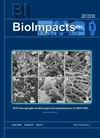一些嘧啶[1,2-b]吡嗪-2- 1衍生物的分子性质预测及抗癌和抗炎活性
IF 2.2
4区 工程技术
Q3 PHARMACOLOGY & PHARMACY
引用次数: 0
摘要
简介:本研究评估了一系列取代7位的新型11嘧啶[1,2-b]吡嗪-2- 1类似物的抗癌和抗炎活性。方法:采用MolSoft软件对其理化特性进行研究。通过MTT细胞活力试验研究其抗增殖活性,细胞周期分析阐明其抗增殖作用机制。Western blot检测关键促凋亡蛋白(Bax、p53)和促生存蛋白(Bcl-2)的表达水平。通过测定RAW264.7细胞中一氧化氮的产生水平和lps激活的THP-1细胞中COX-2酶的表达水平来评估抗炎活性。RT-qPCR检测各促炎因子(IL-6、IL-8、IL-1β、TNF-α)和趋化因子(CCL2、CXCL1、CXCL2、CXCL3)的基因表达。结果:含氯取代基的化合物1对HCT-116和MCF-7的细胞毒活性最高,IC50值分别为49.35±2.685和69.32±3.186µM。化合物1增加促凋亡蛋白p53和Bax的表达,降低促存活蛋白Bcl-2的表达。细胞周期分析显示化合物1在G0/G1期阻滞细胞周期。抗炎实验结果显示,化合物1对NO生成的抑制作用最强,IC50为29.94±2.24µM,并能下调COX-2的表达。化合物1还诱导各种细胞因子和趋化因子的基因表达有统计学意义的降低。结论:嘧啶衍生物1在体外具有较强的抗炎和抗癌作用,可作为进一步研究的先导化合物。本文章由计算机程序翻译,如有差异,请以英文原文为准。
Molecular properties prediction, anticancer and anti-inflammatory activities of some pyrimido[1,2-b]pyridazin-2-one derivatives
Introduction: The anticancer and anti-inflammatory activities of a novel series of eleven pyrimido[1,2-b]pyridazin-2-one analogues substituted at position 7 were assessed in the current study. Methods: The physicochemical characteristics were studied using MolSoft software. The antiproliferative activity was investigated by MTT cell viability assay, and cell cycle analysis elucidated the antiproliferative mechanism of action. Western blot analysis examined the expression levels of key pro-apoptotic (Bax, p53) and pro-survival (Bcl-2) proteins. The anti-inflammatory activity was assessed by measuring the production levels of nitric oxide in RAW264.7 cells, and the expression levels of COX-2 enzyme in LPS-activated THP-1 cells. In addition, the gene expression of various pro-inflammatory cytokines (IL-6, IL-8, IL-1β, TNF-α) and chemokines (CCL2, CXCL1, CXCL2, CXCL3) was assessed by RT-qPCR. Results: Compound 1 bearing a chlorine substituent displayed the highest cytotoxic activity against HCT-116 and MCF-7 cancer cells where IC50 values of 49.35 ± 2.685 and 69.32 ± 3.186 µM, respectively, were achieved. Compound 1 increased the expression of pro-apoptotic proteins p53 and Bax while reducing the expression of pro-survival protein Bcl-2. Cell cycle analysis revealed that compound 1 arrested cell cycle at the G0/G1 phase. Anti-inflammatory assessments revealed that compound 1 displayed the strongest inhibitory activity on NO production with IC50 of 29.94 ± 2.24 µM, and down-regulated the expression of COX-2. Compound 1 also induced a statistically significant decrease in the gene expression of various cytokines and chemokines. Conclusion: These findings showed that the pyrimidine derivative 1 displayed potent anti-inflammatory and anticancer properties in vitro, and can be selected as a lead compound for further investigation.
求助全文
通过发布文献求助,成功后即可免费获取论文全文。
去求助
来源期刊

Bioimpacts
Pharmacology, Toxicology and Pharmaceutics-Pharmaceutical Science
CiteScore
4.80
自引率
7.70%
发文量
36
审稿时长
5 weeks
期刊介绍:
BioImpacts (BI) is a peer-reviewed multidisciplinary international journal, covering original research articles, reviews, commentaries, hypotheses, methodologies, and visions/reflections dealing with all aspects of biological and biomedical researches at molecular, cellular, functional and translational dimensions.
 求助内容:
求助内容: 应助结果提醒方式:
应助结果提醒方式:


